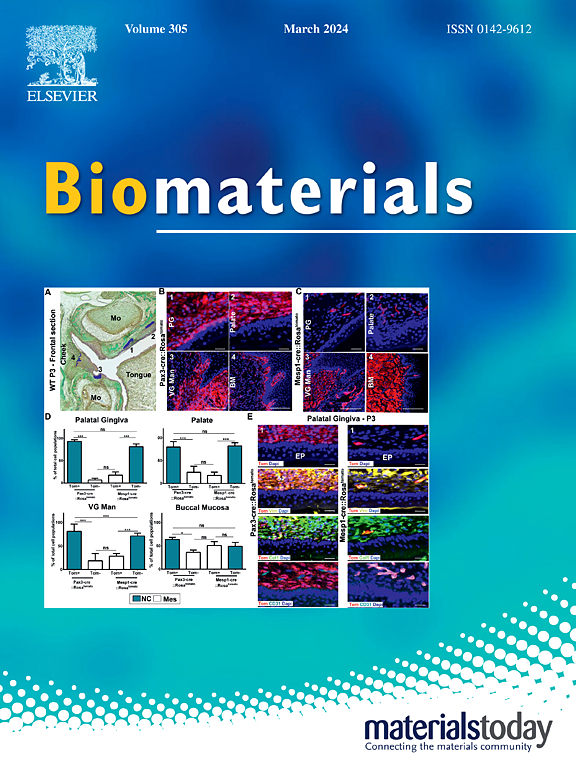脂蛋白激发的原位活化光治疗硝基苯并硒二唑-胆固醇治疗胶质母细胞瘤
IF 12.8
1区 医学
Q1 ENGINEERING, BIOMEDICAL
引用次数: 0
摘要
光治疗材料设计用于在特定光源下的诊断成像和治疗应用,特别是在转化医学中。虽然各种光治疗材料已被开发用于疾病治疗,但它们对生物丰富的物种(如蛋白质)的协同作用很少在生物活性方面进行研究。在这项工作中,我们公开了一种基于硝基苯并硒二唑(NBSD)和胆固醇(Chol)的光治疗剂(命名为NBSD-Chol),该药物可通过脂蛋白杂交原位激活。由于其独特的特性,NBSD-Chol在癌症成像和光动力治疗(PDT)方面表现出了突出的潜力,包括(i)口服后的肿瘤靶向,(ii)在光照射下进行图像引导手术的肿瘤可视化,(iii)优越的PDT效果,(iv)降低与临床关键蛋白相关的风险比(HR)。总的来说,这项工作通过开发利用可见光的癌症创新治疗方法,为推进转化医学做出了贡献,开创了术中技术和光动力荧光引导手术剂的新时代。本文章由计算机程序翻译,如有差异,请以英文原文为准。
Lipoprotein-inspired in situ activatable photo-theranostic nitrobenzoselenadiazole-cholesterol for overcoming glioblastoma
Photo-theranostic materials are designed for both diagnostic imaging and therapeutic applications under specific light sources, particularly in translational medicine. While various photo-theranostic materials have been developed for disease treatment, their cooperative effects on biologically abundant species, such as proteins, have rarely been studied in terms of biological activity. In this work, we disclose a photo-theranostic agent (named NBSD-Chol) based on nitrobenzoselenadiazole (NBSD) and cholesterol (Chol), which is activatable in situ through lipoprotein hybridization. NBSD-Chol demonstrates outstanding potential for cancer imaging and photodynamic therapy (PDT) due to its unique properties, including (i) tumor targeting after oral uptake, (ii) tumor visualization under light irradiation for image-guided surgery, (iii) superior PDT effects, and (iv) downgrading hazard ratios (HR) related to clinically critical proteins. Overall, this work contributes to advancing translational medicine by developing innovative treatments for cancer using visible light, ushering in a new era of intraoperative technology and photodynamic fluorescence-guided surgical agents.
求助全文
通过发布文献求助,成功后即可免费获取论文全文。
去求助
来源期刊

Biomaterials
工程技术-材料科学:生物材料
CiteScore
26.00
自引率
2.90%
发文量
565
审稿时长
46 days
期刊介绍:
Biomaterials is an international journal covering the science and clinical application of biomaterials. A biomaterial is now defined as a substance that has been engineered to take a form which, alone or as part of a complex system, is used to direct, by control of interactions with components of living systems, the course of any therapeutic or diagnostic procedure. It is the aim of the journal to provide a peer-reviewed forum for the publication of original papers and authoritative review and opinion papers dealing with the most important issues facing the use of biomaterials in clinical practice. The scope of the journal covers the wide range of physical, biological and chemical sciences that underpin the design of biomaterials and the clinical disciplines in which they are used. These sciences include polymer synthesis and characterization, drug and gene vector design, the biology of the host response, immunology and toxicology and self assembly at the nanoscale. Clinical applications include the therapies of medical technology and regenerative medicine in all clinical disciplines, and diagnostic systems that reply on innovative contrast and sensing agents. The journal is relevant to areas such as cancer diagnosis and therapy, implantable devices, drug delivery systems, gene vectors, bionanotechnology and tissue engineering.
 求助内容:
求助内容: 应助结果提醒方式:
应助结果提醒方式:


